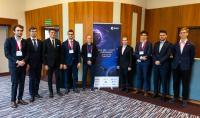WUT's projects at an international conference
Representatives of the Warsaw University of Technology participated in the 12th International Conference on Guidance, Navigation & Control Systems (GNC) – 9th International Conference on Astrodynamics Tools and Techniques (ICATT). They presented papers on the flagship projects of the Student Space Association: the PW-Sat3 satellite and the FOK guided rocket.
The paper "Low-cost AOCs testing solutions for PW-Sat3 CubeSat mission" presents the design of the Attitude and Orbit Control System (AOCS) and the adopted test methodology, which includes model-in-the-loop, software-in-the-loop, processor-in-the-loop, and hardware-in-the-loop tests. For the last stage of testing (hardware-in-the-loop), the team has started working on a station that will enable partial verification of the equipment along with the appropriate software.
The authors of the paper are Michał Kiedrzyński (Student Space Association, Faculty of Mathematics and Information Science), Szymon Jarczewski (Student Space Association, Faculty of Electrical Engineering), Jakub Olesz (Student Space Association, Faculty of Physics), Marek Polewski (Student Space Association, Faculty of Power and Aeronautical Engineering) and Mateusz Sochacki (Division of Automation and Aeronautical Systems, Faculty of Power and Aeronautical Engineering).
In the article "Generation of Artificial Infrared Camera Images for Visual Navigation Simulation," the team from the Rocket Section of the Student Space Association presented two methods of generating artificial thermal images based on real photos captured in visible light. The first method involves correlating the red, green, and blue channels with the infrared radiation channel, while the second method employs a neural network. The artificially generated images will be used in testing the guidance algorithms used in the FOK rocket that is being developed by the Rocket Section.
The paper is the result of the work of a team comprising of: Krystian Zyśk (Student Space Association, Faculty of Power and Aeronautical Engineering), Michał Hałoń (Institute of Control and Computation Engineering, Faculty of Electronics and Information Technology), Kacper Kaczmarek (Student Space Association, Faculty of Power and Aeronautical Engineering), Marcin Kasprzyk (Division of Automation and Aeronautical Systems, Faculty of Power and Aeronautical Engineering), Piotr Rodo (Student Space Association, Faculty of Power and Aeronautical Engineering), Olgierd Skromak (Student Space Association, Faculty of Power and Aeronautical Engineering), Mateusz Sochacki (Division of Automation and Aeronautical Systems, Faculty of Power and Aeronautical Engineering).
The conference provided an opportunity for the representatives of the Warsaw University of Technology to expand their knowledge in the areas of spacecraft navigation and control, as well as astrodynamics. Our students' initiative attracted great interest. During the intervals between the sessions, they engaged in conversations with employees from prominent space agencies such as the European ESA, the American NASA, and the Japanese JAXA, along with representatives from various space industry companies and researchers.
Participation in the conference was made possible thanks to a grant provided by Boeing to the Faculty of Power and Aeronautical Engineering. During the conference, students visited the Polish headquarters of the company located in Gdańsk, including departments focused on software and electronics development (AvioniX), spare parts supply management, mechanical parts design, and aeronautical charts development (Jeppesen).









